Tomorrow night marks the start of Rosh Hashanah, the Jewish New Year. Honey is traditionally served at the Rosh Hashanah table to symbolize our hope for a sweet year ahead. What you may not know, is that honey is rapidly at risk of becoming a scarce commodity.
What I’m about to share with you may sound a bit far-fetched, like a plot from an episode of CSI-The Animal Kingdom Edition, if there were such a version.
Honeybees are disappearing at an alarming rate. Apparently, thriving colonies disappear overnight without leaving a trace, the bodies of the buzzing little victims are never found. Seemingly healthy communities fly off never to return. The queen bee and mother of the hive is abandoned to starve and die.
Bees don’t just make honey; they are critical in the pollination of our fruits and vegetables When you stop to consider that honeybees pollinate about one out of every three bites of food we eat, this is a serious matter. This missing bee phenomenon is known as “Colony Collapse Disorder” (CCD). What is causing CCD is up for debate.
Some put forth the theory that whenever bees are stressed, a parasite, called nosema, attacks the bees digestive system. Anytime bees are stressed, their immune system takes a hit. What could honeybees possibly be stressed about, you may ask? In what’s called “migratory beekeeping”, beehives are often transported long distances to pollinate farms. Imagine how you’d feel, doing a great job on one farm and then being packed up in a truck, to travel thousands of miles only to have to set up shop in a new location all over again. That would stress anyone.
According to Richard Schiffman of blogs.reuters.com
Three new studies point an accusing finger at a culprit that many have suspected all along, a class of pesticides known as neonicotinoids.
In the U.S. alone, these pesticides, produced primarily by the German chemical giant Bayer and known as “neonics” for short, coat a massive 142 million acres of corn, wheat, soy and cotton seeds. They are also a common ingredient in home gardening products.
Research published last month in the prestigious journal Science shows that neonics are absorbed by the plants’ vascular system and contaminate the pollen and nectar that bees encounter on their rounds. They are a nerve poison that disorient their insect victims and appear to damage the homing ability of bees, which may help to account for their mysterious failure to make it back to the hive.
What can we do to help? Here are a few ideas from the “District Domestic” website that you can implement in your garden, to help the plight of the honeybees.
- Replace some of your lawn with flower beds.
- Keep your garden as organic as possible! Avoid using pesticides and herbicides.
- Plant native species, which bees love – for example: mint, daisies, strawberries, raspberries, lavender, salvia, asters, sunflowers and verbena.
- Choose plants that flower at different stages in the growing season to provide a constant supply of food for the bees.
While honey cake is traditionally served at Rosh Hashanah, I have to admit that I’m not the biggest honey cake fan. My main complaint about honey cakes is that they are very sticky and cloyingly sweet.
To me, honey cake is the Jewish equivalent of fruitcake. Everyone makes it but no one really wants to eat it. However, here is a honey cake recipe that I have come upon that has changed my mind. Honey-Glazed Beehive Cake is light and delicate, as a result of egg whites which are whipped to fluffy peaks and then folded into the batter.
The honey glaze which sandwiches the two halves of the hive together is created by combining brown sugar, honey and butter. The brown sugar and butter work their magic to tame the cloying sweetness of honey. I could not stop myself from licking the bowl.
This recipe comes from the June 2008 issue of Martha Stewart Living. I have adapted it slightly and omitted the marzipan honey bees that Martha decorated her cake with. If you have the patience and fine motor skills to make the little marzipan bees, go for it! The hive cake pan is made by Nordicware and I got mine on Amazon.
Egg whites are beaten to stiff peaks and folded into the cake batter to help create a lighter honey cake.
The cake halves must be trimmed in order to sandwich them together to make the hive. The trimmings make a great afternoon snack with tea!
Martha recommends using the honey glaze when it is warm, to glue the halves together. I found that the two sides kept sliding, so I chilled the glaze for about an hour so the butter had a chance to set up a bit. Once firmer, the two halves stuck easily.
The remaining honey glaze can be rewarmed and poured over the cake if you like a “wet-look” sticky cake.
A final sugar glaze is made by mixing icing sugar and water together and poured over the cake.
Click here to print recipe for Beehive Honey Cake.
L’Shana Tova. Wishing you all a sweet, joyous and healthy New Year.

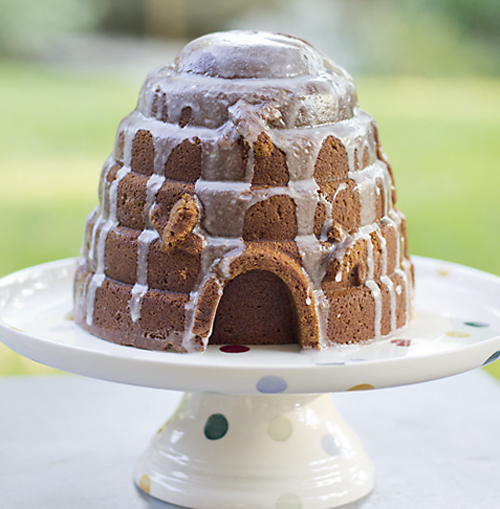
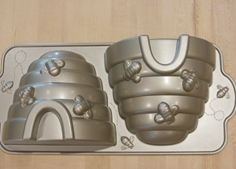
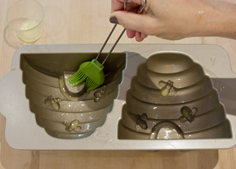
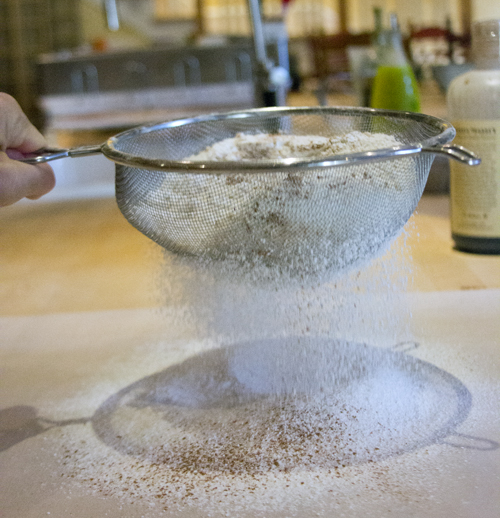
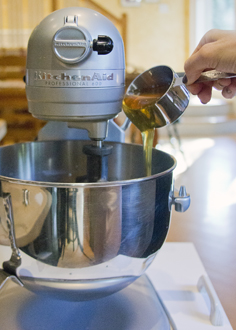
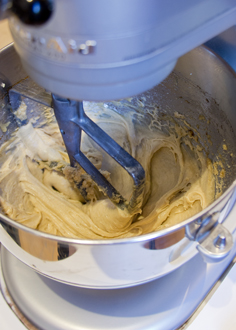
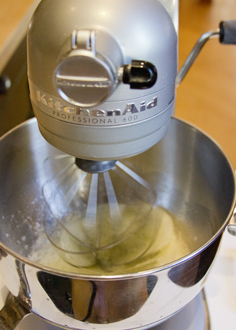
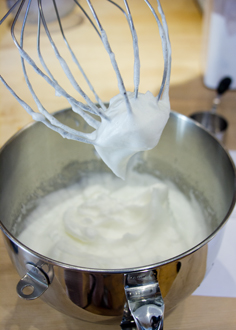
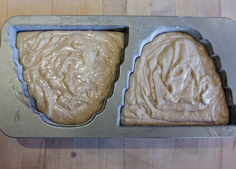
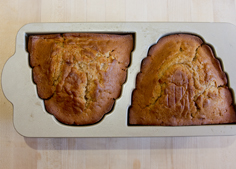
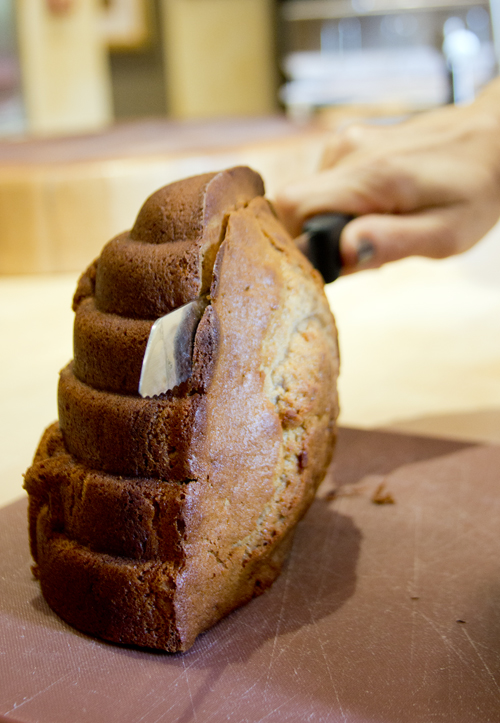
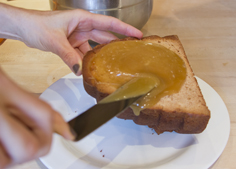
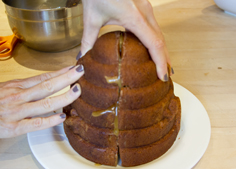
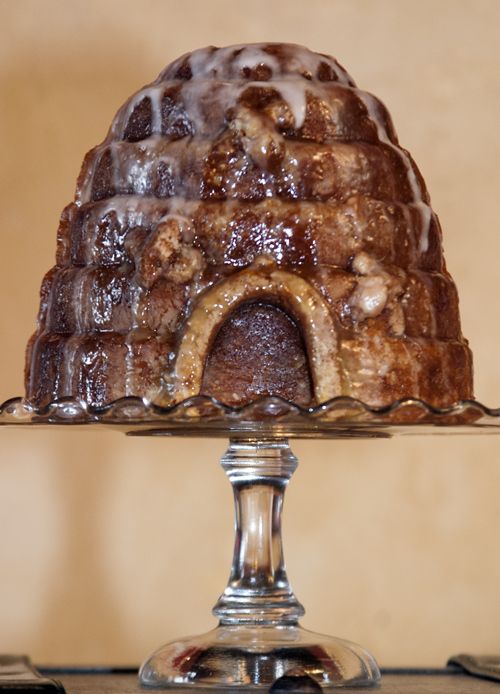
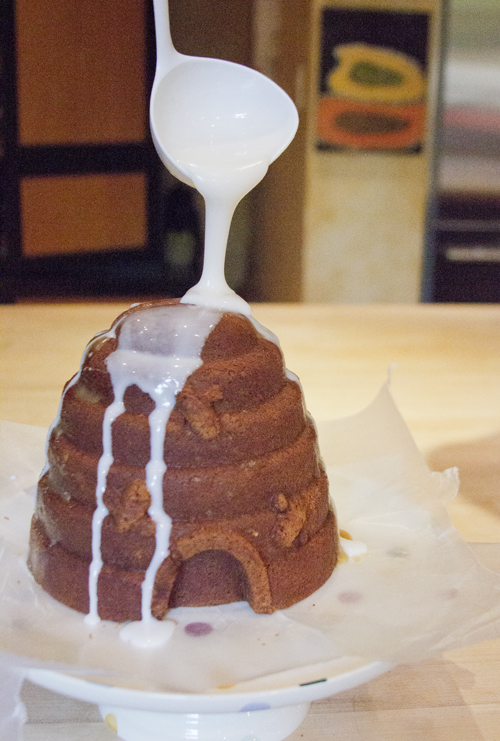
Yummy! Can you send me a piece?
This has got to be one of the most beautiful cakes – if not THE most beautiful cake – I have ever seen in my life. L’shana tova to you as well, and thanks for this recipe which I cannot wait to try. Even just to look at these photos makes me smile, so I can only imagine how my tastebuds will be delighted, as well.
Thanks so much for your sweet comment June. You made me smile today too!
Pingback: Spring 2012 – Honey Inspiration « As Time Goes…Buy
What an outstanding piece. Not only does the finished product sound delicious and look beautiful, we can appreciate the significance of a product we use and probably take for granted…honey! Thank you for making us aware of this growing calamity…and for the positive strategies you give that we can use to help. I just LOVE reading your blogs!!!! L’Shana Tova.
Thanks for your warm and thoughtful comment anonymous, although I think I know who you are!!
Happy New Year! What a beautiful cake. I have to get my hands on one of those cake molds. Amazon here I come!
We just wrapped our 2012 honey harvest. To my amazement our little urban hive gave us 34 pounds of honey–more than enough to make a few hundred honey cakes!
Wow, that is incredible that your little urban hive yielded so much honey. It makes me smile to think of you and Greg out there in your bee gear collecting all that sticky yuminess.
Love love love that bee hive cake pan. You can’t help but smile when you look at it – and that’s what cake should always do!
What a godd ideas ! Your blog ans you photos are so nice! Hag saméah’ and Happy new year
I wish you a blessed Rosh Hashanah, beautiful one! I’m not Jewish but I feel privileged to have learned some of the Jewish tradition through working in a Jewish aged care home for a few years. Such a rich and beautiful culture. Makes me feel a bit culturally devoid, to be honest! I don’t really do any special traditional baking or anything remotely like this incredible hive cake. The glaze looks amazing. Thanks for sharing the info about the bees too. It’s good to be aware of the issues in our ecosystem. I don’t have room for a garden (we live in a tiny apartment) but I’m doing my bit with window boxes for now! I’m also supporting local gardeners in Perth who have tiny domestic hives… we have an apiarist down the street from us who produces the most amazing organic honey. I love how ‘homegrown’ is making a comeback in cities 🙂 x
Thanks for your sweet wishes Laura!
Pingback: Creative Inspiration From the Hive | Wings, Worms, and Wonder
Pingback: Apple & Honey Recipes for the New Year! | Topsy Turvy Toile
I made this cake (Actually 4!!) and it is absolutely delicious. It is not the same texture of the honey cake we make for Rosh Hashana – but maybe that is good! It came out beautifully from the pan which I bought from Nordicware. I will be making this every year from now on. Thanks!
Hi Louise, I am so happy you loved this cake. It is a favourite in our house not just on Rosh Hashanah but all fall long! Shana Tova. A sweet and healthy new year to you and your family.
Omg , I am over 80 and the last thing I need is another cake pan! But guess what, I am going to order this pan and make the cake. How fantastic!
Thanks Mari, It makes me so happy that at over the age of 80 you are still buying new kitchen equipment! I hope I still will be at that age too.
Pingback: 20 Inspired Rosh Hashanah Dinner Ideas
Pingback: 27 Sweetest Treats For Rosh Hashanah | Stress Free Attorney USA
Pingback: Creative Inspiration From the Hive - Wings, Worms and Wonder
Pingback: 27 Sweetest Treats For Rosh Hashanah | Personal Injury Lawyer Team